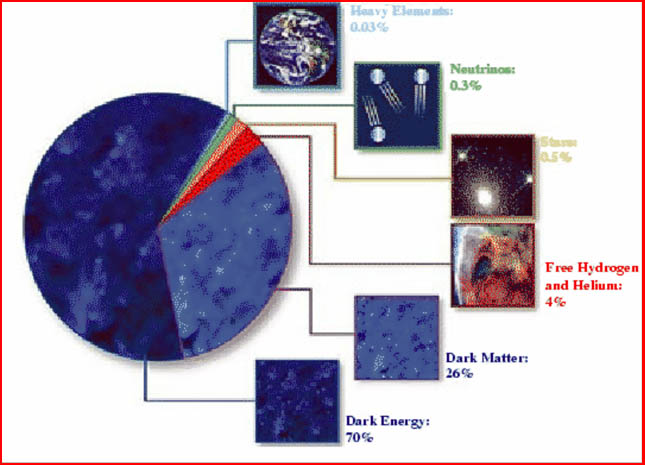
home •
about •
essential guide •
picture of the day •
thunderblogs •
news •
multimedia •
predictions •
products •
get involved •
contact
picture of the day archive subject index
A graphic illustration of the “standard” picture of the universe today. Only about four percent is visible matter.
About 70 percent is “dark energy”. Credit: NASA
Jun 12, 2007
The Ever-Elusive "Dark Energy"Observed motions in the heavens have always posed unsettling challenges to the suppositions of cosmologists. But critics say that things have gotten entirely out of hand with today’s speculations about invisible energy and “accelerating expansion” of the universe.
When astronomers began to analyze discrepancies between motions of spiral galaxies and the requirements of gravitational theory, they found it necessary to postulate large quantities of invisible matter, placed wherever it was needed to “explain” what they were seeing.
At times this remedy reached humorous proportions. When astronomers discovered a vast cloud of hydrogen (VIRGOHI21), estimated to lie some 50 million light-years from Earth, they were perplexed by its speed of rotation. To achieve a fit with their gravitational model, they were forced to invent not just a modest supplement, but a thousand times more “dark matter” than visible matter.
Such leaps of faith, however, are dwarfed by the more recent appeals to a mysterious concept called “dark energy”—summoned to prevent a complete collapse of modern cosmology and in particular its cherished “starting point”, the big bang. Certain principles of the big bang hypothesis are foundational. To give up these principles would be to abandon the hypothesis. One such principle is the standard interpretation of “redshift” (the shift of spectra from distant objects in space toward the red end of the light spectrum). Astronomers view redshift as a reliable indicator of the speed at which an object is moving away from the observer. The result of this interpretation is the now-famous “expanding universe”. Applying assumptions that once seemed obvious, the redshifted objects in space must mean that the universe is growing larger, as the distances between observed objects grows ever greater.
Another foundational principle is that of an electrically neutral, gravity-driven universe. And if gravity is the controlling force, then it follows that distant objects’ velocities of recession, set in motion by the big bang, are slowing down—an inescapable consequence of gravity. In fact, this too was once a foundational assumption of the big bang theory.
But the astronomers’ confidence was shattered when it was realized from the study of a particular class of supernovae, that something was dreadfully wrong. It appeared that the “expansion” of the universe was not slowing down at all. The troublemakers were the “Type Ia” supernovae, which astronomers believed they understood well enough to use as “standard candles”, with a dependable and absolute magnitude that could be compared to apparent magnitudes to give reliable distances.
But when the astronomers plotted the distances against the redshift-determined velocities of recession, the result was a staggering contradiction of their theoretical assumption. The figures suggested that the “expansion” of the universe was accelerating.
Perhaps this would have been a good time to reconsider theoretical assumptions. But instead, the mathematicians, led by cosmologist Michael Turner, embarked on new flights of fancy, envisioning something unseen, untestable, and even more bizarre than dark matter. They imagined that the universe must be filled with invisible energy or “negative pressure”—a kind of “gravity that repels”.
“While gravity gently binds planets, stars and galaxies together, dark energy tugs on the fabric of time and space, pushing galaxies apart ever faster and faster into the farthest reaches of the universe”. (From an article, “Astrophysics Challenged By Dark Energy Finding”, at Space.com, April 10, 2001, emphasis ours).
In these pages, we have challenged the assumptions underlying such unfounded conjectures. What does “dark energy” and “fabric of time and space” really mean? To begin with, cosmologists make a fundamental mistake in ignoring the electric force in the cosmos—a force whose presence has been made abundantly clear by new instruments for imaging objects in space. Supernova 1987a – the closest ever studied – shows that astronomers do not understand the mechanism that produces supernovae: it exhibits unmistakable signs of electrical discharge, contradicting the idea that supernovae can be used as “standard candles” (another idea founded on theoretical supposition, not fact). Indeed, the light curves of supernovae in highly redshifted host galaxies exhibit a number of recognized anomalies. The claim that their “faintness” points to the presence of “dark energy” does not follow, given our present state of ignorance about these objects.
Moreover, the standard assumption that redshift can only be equated with velocity of recession is disputed by some of the world’s most distinguished astronomers, including Halton Arp, the late Fred Hoyle, Geoffrey and Margaret Burbidge, and others. Edwin Hubble himself did not accept the equation as self-evident. It is pretentious to ignore the warnings of highly accredited authorities.
In fact, leading plasma experts tell us that high-energy plasma discharge can produce redshift having no connection to velocity of recession. Hence, it is no longer reasonable to continue with “business as usual”, applying the Doppler interpretation of redshift in disregard of the evidence for intrinsic redshift.
The first requirement, before pursuing the chimera of “dark energy”, is to revisit first principles—a subject we intend to explore in coming Pictures of the Day.
___________________________________________________________________________Please visit our Forum
The Electric Sky and The Electric Universe available now!

|
|

|
EXECUTIVE EDITORS:
David Talbott, Wallace Thornhill
MANAGING EDITORS:
Steve Smith, Mel Acheson
CONTRIBUTING EDITORS: Michael Armstrong, Dwardu Cardona,
Ev Cochrane,
C.J. Ransom, Don Scott, Rens van der Sluijs, Ian Tresman
WEBMASTER: Brian Talbott
Copyright 2007: thunderbolts.info
![]()
home •
thunderblogs •
forum •
picture of the day •
resources •
team •
updates •
contact us

